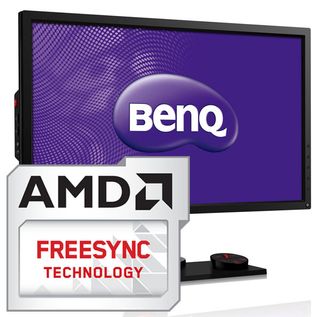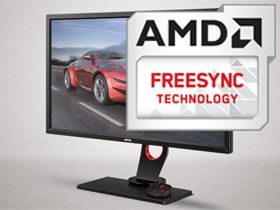Early Verdict
For a first-generation product, BenQ has checked every box except panel technology. We’d prefer an IPS panel but with its other performance virtues, the XL2730Z is a winner in our opinion. It’s not cheap but once you’ve experienced the frame-rate matching offered by FreeSync, you won’t care how much it costs. AMD users finally have their solution and it’s a good one.
Pros
- +
144Hz refresh rate
- +
Blur-reduction
- +
Build quality
- +
FreeSync
- +
Gaming-oriented features
- +
Image accuracy
- +
QHD resolution
- +
S-Switch OSD controller
Cons
- -
Price
- -
TN panel
Why you can trust Tom's Hardware
Introduction
Last August we got our first look at a G-Sync-capable gaming monitor – the Asus ROG Swift PG278Q. By matching incoming frame rates to the monitor’s refresh cycle, stuttering and tearing from moving images is eliminated. It was quite an eye-opener to see it in person after so many simulated demos had circulated online.

Of course G-Sync requires not only a compatible monitor but also a modern GeForce GTX graphics board. That shuts out a legion of AMD users (and even a lot of Nvidia owners) from this slick new tech. FreeSync, added to the DisplayPort standard as Adaptive-Sync, was announced at about the same time as G-Sync and held great promise. As part of DisplayPort 1.2a, it would not require an additional PCB in your display. It would simply be there waiting to connect with the right video card and driver set.
Reality took a little longer to materialize, but today we’re checking out our first FreeSync display, BenQ’s XL2730Z. Known for its quality gaming screens, BenQ takes a QHD resolution panel, adds its tried-and-true gaming features and makes it fully DP1.2a-compatible, which means it supports FreeSync with certain Radeon cards. For a specific list, check out AMD's FreeSync technology page.
Specifications
We’re always hoping for more IPS gaming monitors, but BenQ doesn't answer our wishes here. The XL2730Z uses a TN part from AU Optronics. It’s a brand-new piece sporting 8-bit color depth, 2560x1440 resolution, a 144Hz max refresh rate and a constant-current W-LED backlight. Constant-current means there is no flicker-inducing pulse-width modulation, unless of course you engage the blur-reduction feature.
Blur-reduction is standard fare on pretty much every gaming monitor these days. It’s accomplished by scanning or strobing the backlight between frames. LED’s super-fast response allows this to happen. The big differentiator between products is how much their light output is affected. The amount of time the backlight is actually on determines how much brightness there is. And it’s a Catch-22 proposition. If you want less blur, you have to keep the backlight off for longer.
Some monitors take a large hit to output with blur-reduction engaged (on the order of 65 percent or more). Unless you’re starting with a 450cd/m2 panel, this makes for an extremely dim picture. Better displays include a pulse width adjustment that lets you determine how much output is reduced. BenQ does a superb job in this area. The XL2730Z has one of the best-implemented versions we’ve seen yet. Even on its lowest setting, the blur-reduction improves motion resolution while only dropping output by 35 percent.
Of course there are plenty of other features to talk about, not the least of which is FreeSync. We’ll check that out on our newly-upgraded test system with the latest AMD Catalyst drivers. Page three has instructions on how to enable the technology and page eight has the results of our motion resolution tests. Let’s take a look.

Christian Eberle is a Contributing Editor for Tom's Hardware US. He's a veteran reviewer of A/V equipment, specializing in monitors. Christian began his obsession with tech when he built his first PC in 1991, a 286 running DOS 3.0 at a blazing 12MHz. In 2006, he undertook training from the Imaging Science Foundation in video calibration and testing and thus started a passion for precise imaging that persists to this day. He is also a professional musician with a degree from the New England Conservatory as a classical bassoonist which he used to good effect as a performer with the West Point Army Band from 1987 to 2013. He enjoys watching movies and listening to high-end audio in his custom-built home theater and can be seen riding trails near his home on a race-ready ICE VTX recumbent trike. Christian enjoys the endless summer in Florida where he lives with his wife and Chihuahua and plays with orchestras around the state.

Microsoft Flight Simulator 2024 launch gets stranded on the runway amid launch woes

Nvidia introduces a new merged CPU and GPU AI processor — GB200 Grace Blackwell NVL4 Superchip has four B200 GPUs, two Grace CPUs

Toshiba stuffs an entire PC into a dot matrix printer — Toshiba Jimucon SJ-9500 packs a mysterious CPU, 8GB RAM, and two 240GB SSDs
-
norseman4 I don't understand why the price is so high. The only things I see that are different (in any meaningful way) from the Acer XG270HU (which I have, and am a fan of) is hight adjustment and an external puck to load configurable screen settings. (that is pretty cool though)Reply
The Acer also doesn't have the raised bezel that is actually about 8mm (Top, Left and Right)
The Benq looks like a good monitor, I just don't see what justifies the premium price. -
Xajel I'll wait for 29" 21:9 1440p instead, the only option available is curved, which is pricey, I don't see the curvation worth the extra cost... FreeSync is a plus but this will drive the cost up again ( to have a 144Hz panel at that resolution )... and please add a USB 3.1 hub with 2x Type-A & 2x Type-C portsReply -
eklipz330 i may have missed it in the article, but what is the range of frames freesync covers on this monitor?Reply -
I Hate Nvidia Replyi may have missed it in the article, but what is the range of frames freesync covers on this monitor?
First thing I was thinking of is FreeSync Range , and I double checked the article and there is no mention of it at all! I think the writer is not well informed regarding FreeSync - GSync Range.
-
JTWrenn This was a good article for a monitor review....it was a very bad article for one of the first Freesync monitors to be released. Many of us wanted more info on that and you acted like all monitors are the same as long as the tech works...that is just not true. Please add more about the Freesync tech, how it worked and what it's limitations were.Reply -
singemagique Why does the author not add a comparison to the Acer XB270HU? Instead they make reference to the ROG Swift? At ~$740, the XB270HU offers 1440p, 144hz, and Gsync on an IPS panel and is definitely at the top of my list at this price point. Could Toms please add info on the Acer panel to this review?Reply -
Falkentyne Christian, I sent you an email about Version 4 firmware for the previous monitor you reviewed--the XL2720Z.Reply
And "Area" is the same thing as "strobe phase" is on the older Z series.
http://forums.blurbusters.com/viewtopic.php?f=13&t=560 -
Bondfc11 He says it's 40-144, but has that been tested? Or is that just the normal statement? Recall plenty of FS monitors state a range and then the panel won't oblige once it was properly tested.Reply -
Falkentyne That's the refresh rate capability, NOT the blur reduction rate capability. The older Z series can't even single strobe at 50hz without a Vertical Total tweak which tricks the scaler into using 60hz backlight pulse widths (if you try single strobe at 50hz without it, the backlight becomes overdriven with voltage and the current makes the monitor reset from overcurrent protection.Reply
It can "double strobe" at 50hz and 60hz but that's only because the single strobe option is missing from the service menu (it was there in all of the previous benq blur reduction monitors including the 2430T).
